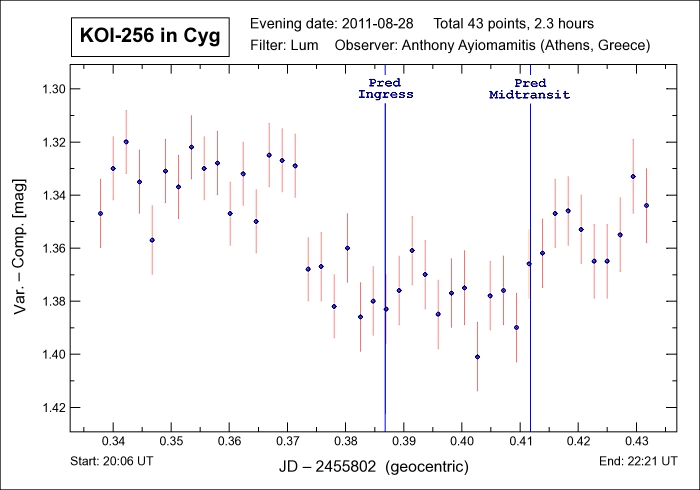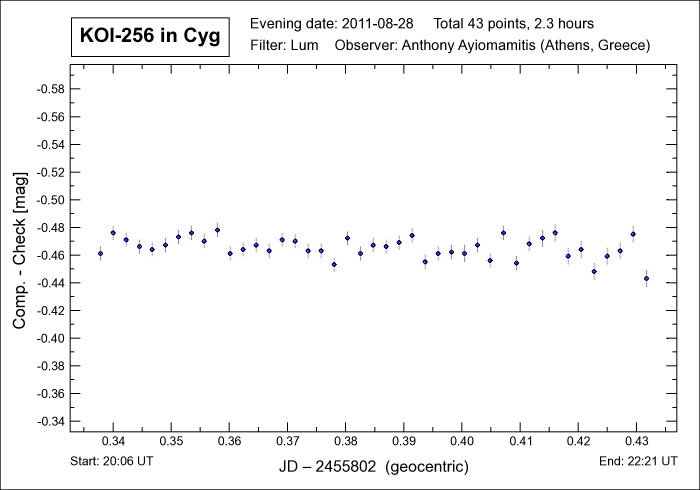
A variable star, as its name suggests, is a star whose magnitude varies intrinsically, in contrast to eclipsing
binaries whose magnitude varies as a result of one star in the binary system eclipsing the other. True variables are
one of five types, namely Mira stars, semiregular stars, cepheids, eruptive variables and, finally, cataclysmic
variables. Minimum to maximum magnitude can range from days to many months with some variables displaying irregular
periods.
A popular method for the study of variable stars, particularly short-term variables, is by the use of the technique
known as "differential photometry". Rather than measure the (variable) magnitude of a variable star on an absolute
scale, measurements are made over time relative to one or more non-variable star(s) and these differences are then
plotted so as to study and illustrate the relative or differential change in magnitude. Due to the very large number
of variables stars, the field of differential photometry represents one of the key fields in astronomy whereby the
amateur astronomer can make a meaningful and long-lasting contribution to both science and astronomy.
More recently, the search for extrasolar planets (510 discovered so far) has identified yet another interesting
application for the practice of differential photometry whereby the minute drops in magnitude of a star hosting an
exoplanet are studied. Further details for the interested party are available
here.
Note: One of the most exciting developments in the field of exoplanet research was the
March/2009 launch of the Kepler satellite and whose primary
mission is to study nearly 150,000 preselected stars on a constant basis for possible transiting earth-like exoplanets
in the habitable zone and whose 105 degree-squared fixed field of view includes the constellations of Cygnus, Lyra and
Draco. It is anticipated that by sampling the fixed field of view every 30 minutes, both hot Jupiter and less-dense
earth-like exoplanets will be identified over the 3.5-year mission.
The light curve for exoplanet KOI 1152b in Cygnus depicted below is one of hundreds of potential transiting exoplanets
discovered by the Kepler mission and which were announced in Feb/2011.
KOI 256b is characterized with a radius equivalent to 14.8 Earth radii and is believed to be the only exoplanet orbiting
KOI 256. It requires 74 minutes to transit its parent star at a depth of 17.2 mmag or 1.72%.
The parent star, KOI 256, is estimated to have a mass of 0.65 solar masses, a radius equivalent to 1.10 solar radii,
a temperature of 3,639° K, a visual magnitude of 15.373 and to lie at a distance of 1,828 light-years away.
Further details regarding KOI 256 and KOI 256b are available in the paper published by the discovery team led by
William Borucki et al here.
Note: The C- and K-stars used for the purposes of the differential photometry measurements
depicted below were GSC 3549:1751 (mag 12.7) and GSC 3549:792 (mag 12.7) respectively.
Worthy of note are the obvious TTV's (time to transit variations) between observed and predicted
times for ingress, midtransit and egress as well as the transit depth (approximately 40 mmag from the light curve below)
which have been observed by professional astronomers and is under further investigation.
Note: For an excellent article on the Kepler mission, see Astronomy Magazine (Nov/2010: 22-27).
|
Parent Star: KID 11548140 GSC/SAO Catalog: N/A Constellation: Cygnus RA / Dec: 19h 00m 44s / +49° 33' 55" Magnitude: 15.373 Distance: 1,828 light-years Exoplanet: KOI-256b Period: 1.378681 d Transit Duration: 73.638 mins Transit Depth: 17.2 mmag Minimum Mass: 0.000Earth Radius: 14.8 REarth Pred Transit Details:
|
 
|
Date: Aug 28-19, 2011 23:05:00 - 01:23:12 UT+3 Location: Athens, Greece Equipment: AP 305/f3.8 Riccardi-Honders AP 1200GTO GEM SBIG ST-10XME SBIG CFW-10 SBIG LRGB filters Integrations:
Temperatures:
Software: CCDSoft V5.00.201 AIP4Win V2.2 Processing: Reduction Differential Photometry |